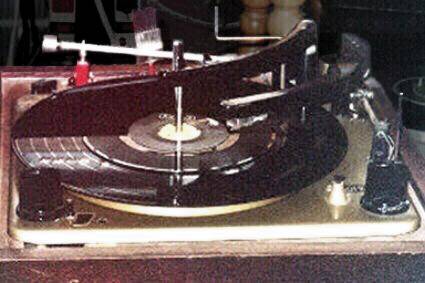- ELAC Miracord was the first to go, in 1960, with the PW-10 and PW-50. These
units were made with an umbrella spindle, and four pushbuttons, for 7" START,
10" START, 12" START, and STOP (STOP returned the arm and shut the changer
off without dropping a record). One nasty habit this changer had was snatching the
arm out of your hand as you picked it up from the restpost, and throwing it toward
the center of the record. ELAC never got rid of this problem.
One question I have is: Why didn't they include the automatic size selection found in their PW-161? It would have added to the functionality without adding to the price. The pushbuttons would be START, 10" SINGLE, 12" SINGLE, and STOP.
- Dual was next. In 1961, Dual produced the 1007, an umbrella changer with a size switch with 4 sizes on it - 7", 8", 10", and 12". But it still produced the 1006 at the same time.
- In 1964, Dual made the 1009, abandoning 1006 (with an index that could already do automatic single play) for a changer with a 7" 10" 12" size switch. But Dual kept the other features of the 1006, except the repeat button, and added a fully balanced arm. After 1966, Dual put size switches on all of its changers.
- Garrard, on the other hand, added single play spindles, but otherwise left their A series and their AT series alone, in 1964. The AT changers could be persuaded to set down automatically on the correct size if you knew where to position the overarm during the change cycle. But you then had to lower the overarm while the record was playing, or part of the record would repeat. Garrard also changed their overarm 45 spindles from a spindle slicer to a pusher spindle with one slicer blade instead of a latch.

Garrard AT-60
- Garrard introduced the Lab-80 in 1964. This was their only changer with an umbrella spindle. But even this still used the pusher principle, because there was only one wedge in the spindle, and it pushed all of the records except the bottom one to one side before it wedged them to the spindle. This allowed a weaker wedge to be used, one gentler on the records. Lab-80 was the first record changer with a cue control. But Lab-80 played at only 33 and 45, and it used a record-size switch. It also had no safety drive, and the arm could not be placed on the restpost by hand after it was automatically positioned on a record. The A-70, an upgrade of the A MkII, also had this problem.
- In 1964, BSR shortened their spindles so they held only 6 records, but they retained the drop feeler intermix index. They also introduced those crummy flat large-hole spindles at this time.
- By 1965, Webcor, Luxor, Philco, and many other changer manufacturers had disappeared from the market. V-M, GE, Silvertone, and RCA were the only US manufacturers of record changers left. GE bought Glaser-Steers in 1965.

Garrard Lab-80
- In 1965, Silvertone switched from a Collaro-type drop feeler to a semaphore, and shortened its spindle to hold only 6 records. Singer started selling compacts containing the Silvertone changer. They also started using flat large-hole spindles then.
- GE continued to produce the Glaser-Steers basic design for a few years, but without the Speedminder.
- In 1966, Collaro (now in its guise as Magnavox) modified its arm-scan index so it became a 3-size changer instead of a changer able to index odd sizes. Amazingly, it continued to produce this basic changer design until it stopped making record changers in 1993. The only major changes in later years were the addition of the cue control in 1970, and making the spindle removable and supplying a short spindle in 1972. They even kept the 10-record capacity throughout.
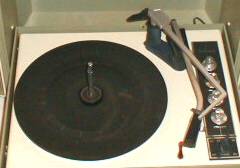
Silvertone semaphore changer
- In 1966, Dual and Miracord added cue controls to their record changers. Although the Dual 1019 (1967, pictured at right) had a record-size switch, it also had one of the best arms ever made on a record changer. Both companies stopped making their intermix changers at the same time.
- The next to fall was BSR (in 1967). They replaced the drop feeler with a size switch in all but the mini-changer, which used V-M Tri-O-Matic-style feelers. All BSR changers at this point used overarms.
- In 1967, Garrard replaced their top of the line changers with the SL-95 and SL-75, a rather appalling pair of units with rather limited record changing ability. A speed-size switch selected 12", 10", or 7" 33-RPM records, 7" 45-RPM records, or 12" 78-RPM records. Notice that the 10" 78 was omitted, even though there are more 10" 78s than 12" 78s. The movable pusher shelf was replaced with a fixed shelf, which could work only with 12" records, and the record pusher was moved to the spindle. That meant that these changers could change only 12" 33s and 12" 78s, plus 7" 45s if you bought the large-hole spindle. These could hold only 6 records. A later version of this fixed-shelf-type changer, the SL-72 is shown below to the right. The record pusher moved backwards against the record hole, to check for record presence for automatic shutoff purposes.
- Garrard left the AT-series alone, at this time, except for a change to a synchronous motor, the addition of cue controls, and renaming the AT-50 to SL-55 and the AT-60 to SL-65. No Garrard ever made could hold more than 8 records, so they didn't shorten their spindles at this time.
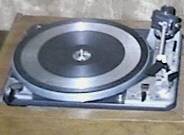
Dual 1019

BSR 800
- In 1967, although they kept the Tri-O-Matic design, V-M shortened their spindles to hold only 6 records, and introduced flat large-hole spindles.
- In 1968, RCA and GE abandoned their intermix indexes and switched to making record changers with size switches. They also shortened the spindles so they could hold only 6 records. But neither made their spindles removable. Both started using offset flat large-hole spindles with no moving parts in them at this time.
- In 1969, Garrard removed the semaphores from their overarm changers, and changed to a speed-size switch, dropping the 16-RPM speed. The new versions could play only 12", or 7" 33-RPM, 7" 45-RPM, or 10" 78-RPM records. This time, they left out the 12" 78 and 10" 33. They also came up with a goofy way of moving the overarm to the rear for single play. But their shelf-type changers still provided the earlier combination of speeds and sizes. Maybe you were supposed to buy the shelf-type if you were into classical music or '50s popular music, or the overarm-type if you were into popular music of the '40s or '60s. The fixed-shelf-type SL-72B is shown at right.
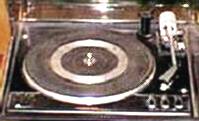
Garrard SL-72B
- In 1969, most compact stereo makers had switched from the V-M Tri-O-Matic to the BSR overarm changers with size switches.
- In 1970, BSR produced an umbrella changer that had the look and feel of the Miracord changers, but had only 33 and 45. Why? It had a very different change cycle mechanism underneath, using a horizontal camshaft.
- Garrard in 1970 introduced its Zero-100 record changer, a 2-speed (33 and 45) version of the SL-95B shelf-type changer, with a pantographic arm for tangent tracking of the record. It also discontinued models 30 and 3000 at this time, so it had no intermix changers left. From 1970 on, no Garrard record changer made could play all standard types of records. Garrard also switched to flat large-hole spindles in 1970.
- Also in 1970, Perpetuum Ebner (PE) re-entered the record changer market in the US, with an umbrella spindle changer that held 10 records. It used rising feelers to sense the size of the first record on the platter, and also to sense the absence of records. This was a nice safety device that prevented the stylus from setting on an empty turntable.
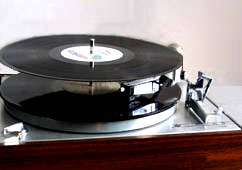
Perpetuum Ebner PE-2020
- In 1970, Dual shortened its spindle in its 1212 so it held only 6 records, but it also replaced the rubber wedges that habitually failed with metal ones that did not fail. The similar Dual 1209, from 1972, is pictured here. Dual then proceeded to make 1200-series versions of all of the 1000-series changers they replaced.
- In 1971, V-M added some models with size switches, completely discarding the Tri-O-Matic index in 1973. Of course, these didn't sell very well.
- In 1970, V-M also reintroduced the elevator changer with arm scan, now with a standard-sized headshell. They continued to sell this for about 7 years as the V-M 1555 and 1585. Sherwood sold it as the SEL-100. It would have sold better if it had included the 78 RPM speed, because most odd-size records are 78 RPM.
- In 1973, V-M made a manual version, the 1579. Some reviewers mistook a photo of this for a removable-spindle version of 1585, misleading buyers.
- In 1971, BSR added more umbrella changers to its line, but still produced overarm changers. In 1973, they made one umbrella changer that could hold only 3 records. Who they were trying to entice is not known. The manual turntable purist would not use the umbrella spindle, and the changer user would want more capacity.
- Philips created model GC047 in 1971. These use an arm scan, but for only the 3 standard sizes. The arm did a scan similar to the new Collaro scan, but only touched 10" or 12" records. It never actually touched the 7" record, but came to a stop near it. Then the arm lowered, the record dropped, and the arm and moved in to set down. The arm did not scan if the overarm was low, indicating that the spindle was empty of records. This changer required that larger records be placed below smaller records in the stack.
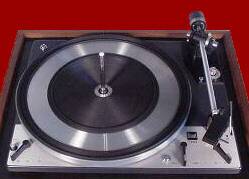
Dual 1209
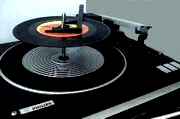
Philips GC047 doing an arm scan
- In 1971, Panasonic (Japan) started selling a mini changer with a falling record sensor similar to that on the Glaser-Steers. They disappeared within 2 years, replaced by the now ubiquitous BSR overarm changer with the size switch.
- Dual goofed in 1971 with the 1219. It put in a lever that raised the arm pivot for changer operation, and lowered it for single play. This made the vertical tracking angle more accurate. To keep the arm from being used in the wrong position, the record would not drop and the changer shut off if it was started with the changer spindle installed while in the single play position. But if the unit was in the multiple play position, the cue control didn't work. This caused many complaints, and Dual quickly modified the 1219 so the cue control would work in a record stack.
- In 1973, Dual modified the 1229 to make the 1229Q. This had special tonearm wiring for the newly-introduced CD-4 quadraphonic system. The CD-4 system quickly died, because a slightly worn record sounded like sandpaper. Dust on the record produced crashes instead of clicks.
- In 1972, Panasonic produced a series of changers similar to the Dual ones. They had umbrella spindles, but also had a manual start position on the control lever. Sony (Japan) came out with a similar changer, but with totally different styling. One version came with a built-in CD-4 decoder.
- Also in 1972, Garrard turntables were no longer imported into the US, because the US Consumer Products Safety Commission banned Delrin (the slippery plastic in all Garrard trip mechanisms) as a fire-spreading hazard. In a fire, Delrin melted, ran, and burned, spreading the fire.
- With the departure of Garrard, British Industries Corporation (B.I.C. - US), the company who had imported Garrard into the US, produced a line of very stupid changers. These changers had the same kind of 12" shelf and pusher spindle that Garrard had used, but played only 12" 33 and 7" 45. They couldn't even sense the absence of records on the spindle, so the user had to tell them how many records were stacked. They had no sensing devices at all, other than a velocity trip. Bleaugh!
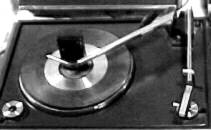
Panasonic mini
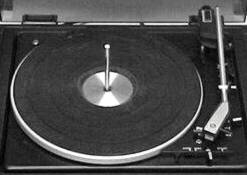
Panasonic RD620
- In 1972, Magnavox started using a 2-speed Philips mini changer with a forked overarm. It selected both the size and speed by whether the first record on the turntable had a large hole (7" 45) or a small hole (12" 33). It didn't sell well. Double bleaugh!!
- Magnavox also used a tiny 3-speed V-M changer as a third choice. But the regular Collaro line was still selling well in high-end Magnavox consoles.
- In 1973, Miracord dropped the 78 speed, and made changers that could take only 12" 33s and 7" 45s. They combined the speed and size into one knob. Dual (and PE, by then owned by Dual) followed suit the following year. Triple bleaugh!!!
- Collaro also put out a component record changer under its own name (seen at right). This combined a precision tonearm with the 3-size pickup-arm scan Collaro used since 1967. The spindle could be interchanged, and the overarm could even be removed for single-play use. Nice!
- McDonald, the company that had been importing BSR turntables into the US, started selling Glenburn (US) changers, which were cheap knockoffs of the BSR overarm changer design, which had been discontinued to make the BSR umbrella changers.
- In 1973, Panasonic built a record changer with the overarm in the dust cover. It was a circular spring-loaded ring that surrounded the spindle.
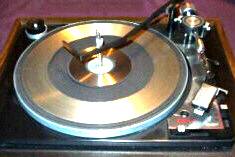
Component Collaro
- In 1974, BSR-ADC produced their Accutrack +6, a changer that could be programmed to play just selected cuts from each record. Amazingly, the unit could not intermix record sizes, and was limited to 12" 33 and 7" 45. The spindle was umbrella, but a raiser came up from the turntable during the change cycle. This raised the records up before the next one dropped, so it fell only one inch. It could also put the stack back up on the spindle.
- In 1976, BSR had switched to using speed-size switches, providing 12" 33 and 7" 45 on some models, and adding 10" 78 on others. They also switched back to overarms.
- In 1976, Dual stopped making record changers, and concentrated on electronic drive single play turntables with automatic arms.
- Record changer sales plummeted in the middle 1970s, partly due to the economic woes, and partly due to the fact that most people had their old intermix changers repaired, rather than buy the rather useless new ones.
- V-M went bankrupt in 1977.
- By 1980, cassettes had become the dominant form of recorded music.

ADC Accutrack +6.
- In 1982, the Compact Disc (CD) was released on the market. The doom of the phonograph record was sealed.
- By 1984, BSR and Collaro (Magnavox) were the only companies producing record changers. Dual had gone bankrupt, and was bought by PE.
- In the late 1980s, Pioneer briefly made a record changer that used a magazine of drawers (similar to the CD-changer mechanism). But it took only 12" 33s - 6 of them.
- In 1992, LPs became unavailable. The 45 held on a year longer, because a satisfactory replacement to be used in CD players was not yet available. The 3" CD they tried first got lost inside many CD players. It was eventually replaced with a standard 5" CD with just 4 songs on it.
- Both BSR and Collaro stopped making record changers in 1993, when the mass production of phonograph records ceased. A few cheapened versions of B.I.C. changers have appeared occasionally in compacts since then, but they seem to be just a sell-off of old stock. Plastic changer spindles???
This ends the period of the record changer. The CD had totally replaced the phonograph record. From 1993 onward, no record changers were manufactured. And unfortunately, the replacement parts for most changers are gone too. It's a sad ending to a wonderful era of innovation.
But some people still use record changers. The author of this page is still using a 1961 Collaro Conquest. And it has needed repair only 3 times in 46 years.
Addendum: Some retro phonograph cabinets appeared in 2004 going by such 1940s and 1950s names as Detrola and Trav-ler. They contain cheap record changers designed in the 1980s, which were originally sold by Glenburn and B.I.C. It isn't known whether these are being made now, or are old stock being sold off. But these are mere minimal-quality ghosts of the changers that existed before.
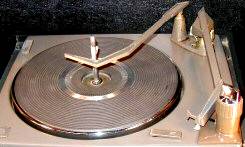
The last record changer:
a Magnavox Micromatic
made by Collaro
